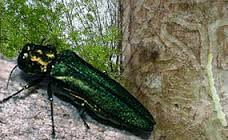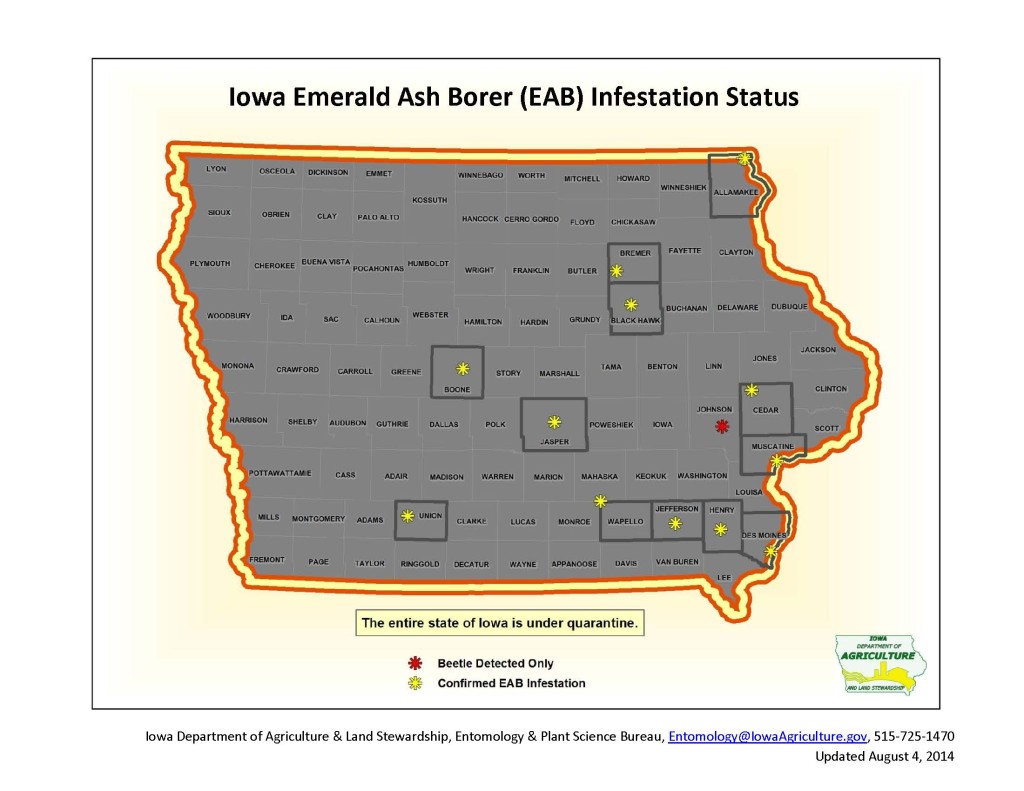
The Iowa Department of Natural Resources confirmed Monday that two adult emerald ash borer (EAB) beetles have been collected from a trap in a residential tree in Boone. Boone County is the 11th county in Iowa, and the first county contiguous to Greene, where EAB have been identified.
The trap was placed in the tree after suspect galleries were found in a branch that fell from the tree during a storm earlier this summer.
Lynn Menz, chair of the Jefferson tree committee, and Brad Riphagen, a Jefferson resident and field coordinator for Trees Forever, talked with the Jefferson city council last November about the city’s trees and the EAB threat. At that time, Fairfield in Jefferson County was the nearest community with identified EAB. ISU Extension & Outreach of Greene County partnered with the Jefferson tree committee to hold an informational meeting on EAB in April. At that time EAB had been confirmed in nine Iowa counties.
Riphagen on Tuesday explained what property owners who are concerned about their trees should do in response to the nearness of EAB.
According to Riphagen, the first step is to be sure the tree in question is an ash tree, as EAB is specific only to ash trees. In November, he estimated about 30 percent of the trees in the public right of way in Jefferson are ash trees. He said that across Iowa, between 10 and 20 percent of the public trees are ash trees. The majority of trees in Iowa are not ash trees and will not be affected by EAB.

He explained that EAB don’t eat the leaves from a tree like Japanese beetles do. Instead, they drill holes in the bark into which they lay their eggs. The larva then burrow into the wood creating curving grooves – galleries – under the bark, and then emerge back through the bark as adult insects. EAB will girdle a tree with galleries, eventually killing the tree.
Homeowners won’t see EAB on the leaves, particularly at this time of year. The galleries are in branches 4 inches in diameter or smaller, usually higher up in a tree in the early stages. There is typically some natural die back of branches at the top of an ash tree, making it more difficult to spot EAB damage from the ground. The only sure way to know if a tree is infected, Riphagen said, is to sample branches from the tree.
The only preventive measure to use against EAB at this time of year is an injection into the trunk of the tree. Other preventive measures, like soil injection, a soil drench, and a basal trunk spray, must be applied in the spring. Those preventive steps were discussed by the city council last November, but they appeared to be cost prohibitive for the city.
Adult EAB can fly two to five miles. EAB is more often spread by transporting infected firewood, nursery plants or sawmill logs. The DNR issued a statewide quarantine restricting the movement of hardwood firewood, ash logs, wood chips and ash tree nursery stock out of Iowa into non-quarantined areas of other states last February.
Riphagen said the best step Greene County residents can take to thwart EAB is not to move firewood. He added, though, that it may already be too late. EAB can be in an area four or five years before they’re detected.
Also, the Jefferson tree committee has already gotten a commitment from the Iowa DNR to do an inventory of all public trees in Jefferson next spring. The city of Boone has previously completed an inventory of its trees, and is in the process of assessing the condition of all ash trees in the city right-of-way.
Information about emerald ash borer is available on the Trees Forever website or on the Iowa DNR website.
